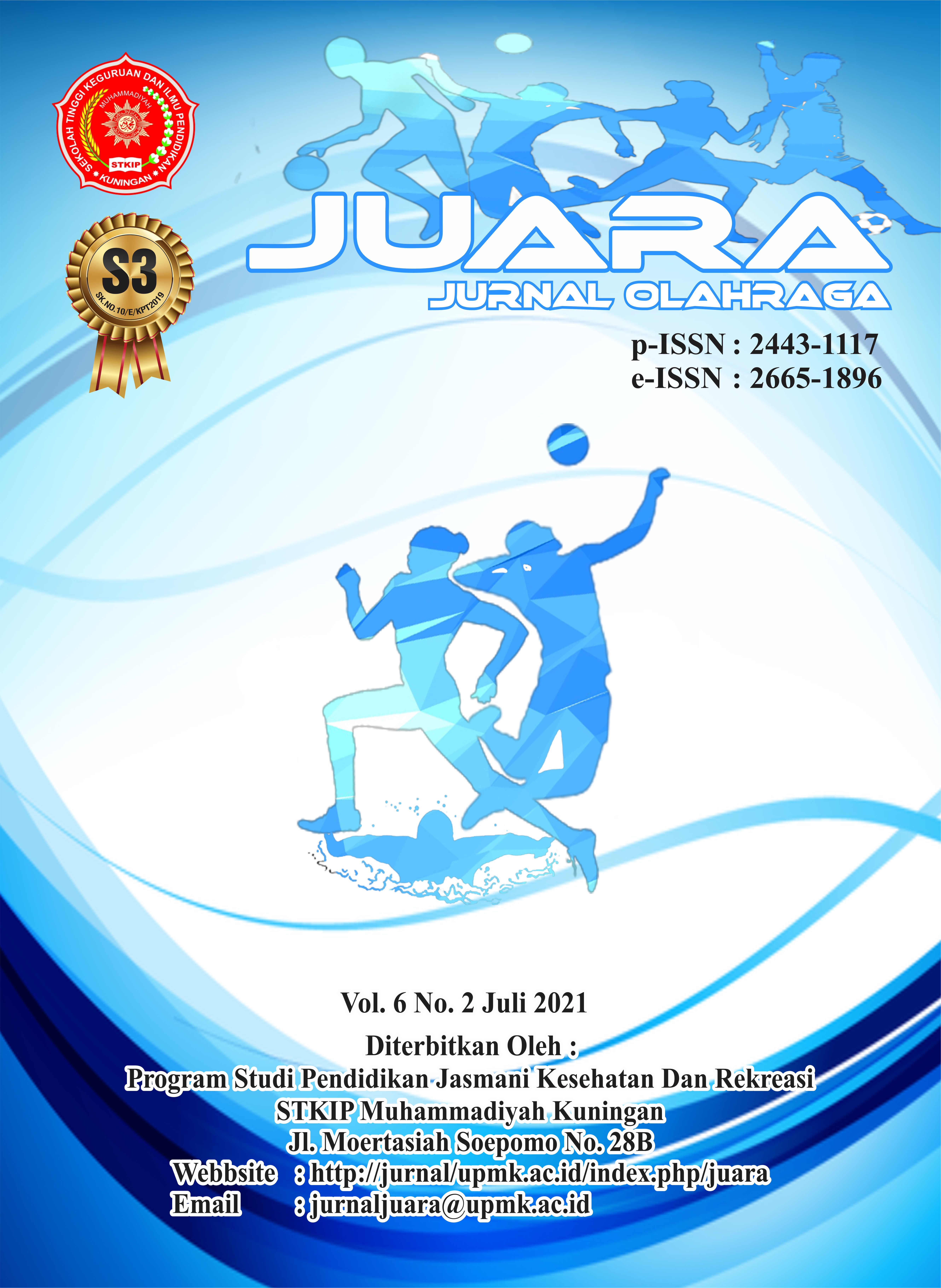Abstract
Some types of traditional games, such as bebentengan, have the same movements as some physical activities commonly carried out by individuals. Several studies on the effect of bebentengan on performance are still limited, so it is necessary to research the impact of bebentengan game treatment on aerobic capacity and agility. The research method used is an experimental method with one group pretest and posttest design without a control group, involving 20 teenagers from Serang City, Banten Province. The results showed that the bebetengan game treatment for three months increased the proportion of aerobic capacity by 5.27% and agility aspects by 3.28%. This study concludes that bebentengan games positively affect aerobic capacity and agility aspects in research subjects and can be used as an alternative to physical activity exercises.
References
Bahri, Samsul, Dadan Resmana, Haryo Satrio Tomo, and Doddy Abdul Karim1. 2017. “TERHADAP NILAI VO2MAX Program Studi Sains Keolahragaan Sekolah Farmasi Insititut Teknologi Bandung1 , Fakultas Metode Penelitian Hasil Dan Pembahasan.” 27–30.
Barene, S., P. Krustrup, S. R. Jackman, O. L. Brekke, and A. Holtermann. 2014. “Do Soccer and Zumba Exercise Improve Fitness and Indicators of Health among Female Hospital Employees? A 12-Week RCT.” Scandinavian Journal of Medicine and Science in Sports 24(6):990–99. doi: 10.1111/sms.12138.
Bouchard C and Blair, S.N (2012). Physical Activity and Health 2nd Edition. Human Kinetics
Fortes García, Rafael Chieza, Rafael Melo de Oliveira, Eduardo Camilo Martínez, and Eduardo Borba Neves. 2019. “VO2 Estimation Equation Accuracy to Young Adults.” Archivos de Medicina (Manizales) 20(1):33–39. doi: 10.30554/archmed.20.1.3476.2020.
Hasanah, Uswatun. 2016. “Pengembangan Kemampuan Fisik Motorik Melalui Permainan Tradisional Bagi Anak Usia Dini.” Jurnal Pendidikan Anak 5(1):717–33. doi: 10.21831/jpa.v5i1.12368.
Hoofman, S.J., Harris, J.C. Studying Physical Activity. Human Kinetics
Guyton, A.C., Hall, J.E (2008). Buku Ajar Fisiologi Kedokteran. Edisi 11. Jakarta: EGC.
Irfansyah, Ukasyah Q. A. P. 2015. “ABSTRAK Seseorang Yang Bermain Game Akan Mengeluarkan Energi Di Bawah 1,5 METs. Hal Itu Termasuk Dalam.” Jurnal Sosioteknologi 124–40.
Kwilasz, A. J. 2016. “乳鼠心肌提取 HHS Public Access.” Physiology & Behavior 176(1):139–48. doi: 10.1016/j.mayocp.2015.07.026.Reference.
Kenney, W.L (2012). Physiology of Sport and Exercise 5th ed. Human Kinetics
Mathisen, Gunnar Elling, and Svein Arne Pettersen. 2018. “The Effect of Speed Training on Sprint and Agility Performance in 15-Year-Old Female Soccer Players.” LASE Journal of Sport Science 6(1):61–70. doi: 10.1515/ljss-2016-0006.
Nurdiansyah, Dani. 2018. “Pengaruh Permainan Tradisional Hadang Terhadap Agility.” JUARA : Jurnal Olahraga 3(2):77. doi: 10.33222/juara.v3i2.238.
Nuriman, Ramdhan, Nurlan Kusmaedi, and Sumardi Yanto. 2016. “Pengaruh Permainan Olahraga Tradisional Bebentengan Terhadap Kemampuan Kelincahan Anak Usia 8-9 Tahun.” Jurnal Terapan Ilmu Keolahragaan 1(1):29. doi: 10.17509/jtikor.v1i1.1550.
Park, Sin Ae, Ji Young Lee, Kwan Suk Lee, and Ki Cheol Son. 2014. “Metabolic Costs of Daily Activities in Community-Dwelling Older Adults.” International Journal of Gerontology 8(4):228–29. doi: 10.1016/j.ijge.2014.03.006.
Penduduk, Pada, Indonesia Yang, Sehat Berdasarkan, Hasil Riskesdas, Sri Muljati, Agus Triwinarto, Nurhandayani Utami, Pusat Penelitian, Upaya Kesehatan, and Badan Penelitian. 2016. “Gambaran Median Tinggi Badan Dan Berat Badan … ( Muljati S; Dkk).” 2013(2):137–44.
Soediono, Budi. 2014. “INFO DATIN KEMENKES RI Kondisi Pencapaian Program Kesehatan Anak Indonesia.” Journal of Chemical Information and Modeling 53:160. doi: 10.1017/CBO9781107415324.004.
Tomioka, Kimiko, Junko Iwamoto, Keigo Saeki, and Nozomi Okamoto. 2011. “Reliability and Validity of the International Physical Activity Questionnaire (IPAQ) in Elderly Adults: The Fujiwara-Kyo Study.” Journal of Epidemiology 21(6):459–65. doi: 10.2188/jea.JE20110003.
World Health Organization. 2018. “2018 Global Reference List of 100 Core Health Indicators (plus Health-Related SDGs).”

This work is licensed under a Creative Commons Attribution-ShareAlike 4.0 International License.


